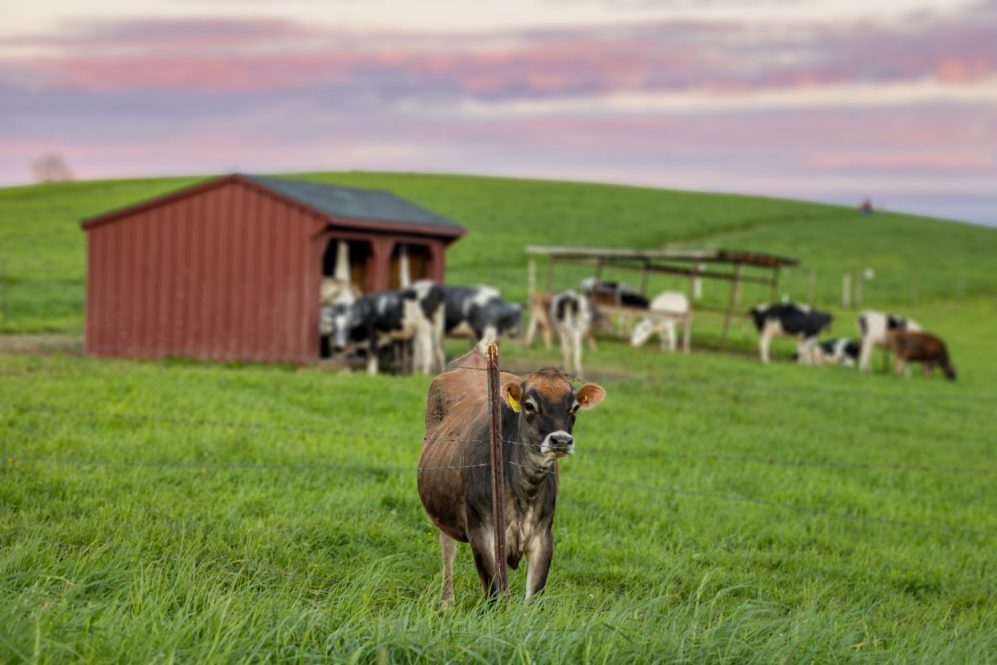Horsebarn Hill is one of the most iconic features of the UConn Storrs campus.
But what many people may not realize is that this picturesque spot is also a working farm raising hundreds of animals and growing the crops that feed them.
The plants and animals on Horsebarn Hill support education, extension, and research in the College of Agriculture, Health and Natural Resources.
There are currently 262 cows living on Horsebarn Hill, including 95 milk cows, 97 heifers (young females), 39 beef cows, and 31 calves.
“UConn’s herd is such an important part of the University’s history as an agricultural college, but people may not be aware of how technologically advanced and impactful these animals and facilities are for students, researchers, and the state,” says incoming department head Pedram Rezamand, an internationally recognized expert in ruminant nutrition. “We’re committed to keeping our cows healthy and happy and sharing them with the UConn community.”
Head of the Class
The cows are used for academic programs, research, and community engagement through the Department of Animal Science.
UConn is the only university in the Northeast with such easy access to farm animals on campus. Thanks to the inclusion of five species housed on Horsebarn Hill, students can take courses on dairy management, dairy cattle evaluation, dairy herd management, nutrition, growth biology and metabolism, and behavior and training, poultry science, horse riding and training, among others.
Students work with the cows in their coursework – weighing, measuring, and performing ultrasounds to study reproduction and growth. Students also handle and train the animals for a unique first-year course that culminates with the “Little I” show.
Mary Margaret Smith, executive program director for the dairy and livestock units, says most students in the program do not come from a farming background and their first experience handling large agricultural animals is at UConn.
“It’s invaluable to them, to be able to interact with these animals in a gradual setting and become more comfortable with them,” Smith says.
For students who want to become dairy managers, UConn provides them not only with experience handling cows and conduct research, but with the kind of innovative technology dairies use, like robotic milkers. UConn was one of the first universities in the United States to adopt robotic milking, which is considered the most technologically advanced way of managing and studying a dairy herd.
“If they’re going to be a dairy manager today, they’re going to manage some kind of technology,” Smith says. “So, we can provide them with a really good background.”
Community Connections
Horsebarn Hill and the University’s dairy production help connect residents across Connecticut with the University thanks to engagement programs as well as the award-winning Dairy Bar ice cream and cheese produced from the milk. In operation since 1953, UConn’s Creamery produces up to 50,000 gallons of ice cream per year.
The facilities at Horsebarn Hill also serve as the location for a host of community events through UConn Extension. Specifically, Horsebarn Hill offers unique space for youth from youth agricultural organizations UConn 4-H and FFA to practice dairy and beef judging, anatomical demonstrations, and hoof-trimming practice.
“It’s a lot of hands-on activities for the kids,” Smith says.
Research Beyond the Lab
UConn researchers complete high-quality research on cattle focusing on all stages of the animals’ lifetime.
In 1999, the late Xiangzhong “Jerry” Yang successfully cloned a calf named Amy using an ear cell from a genetically elite cow of the UConn herd. This was the first time anyone had cloned a farm animal in the United States.
“Over the years, the farm has supported many important research projects,” Cindy Tian, professor of animal science and Yang’s widow, says. “The farm has a long history of supporting world-renowned research and continues to do so.”
Some examples of the types of work that Horsebarn Hill and the animals that call it home include pluripotent bovine stem cells for cultivated meat research, nutrition of cross breeding, animal reproduction, genetics, and dairy and cheese production.
Importantly, all of this work is possible because Horsebarn Hill is a working farm that provides its cattle with the feed and space they need to be healthy.
Stewards of the Land
The 40-acre hay field on Horsebarn Hill produces an average of three hay cuttings each year from May to August totaling an average of 150 acres of hay.
The hay provides 75% of the heifer cattle’s diet and 10% for lactating cows. Corn, another large part of the cows’ diet, also grows on Horsebarn Hill.
When hay or corn is not growing in the area, it is used as pasture for cattle.
This is why people driving through the hayfields or leaving trash on Horsebarn Hill is a major issue.
Driving can cause permanent damage to the field and trash like aluminum cans pose a particularly dangerous problem. The machine used to harvest the hay has a magnet to extract other metals, but not aluminum. This means the cans can get into the hay and be ingested by the cows.
“Cows are indiscriminate eaters,” Smith says. “So then when they eat, they could ingest the aluminum and it could cause serious and fatal damage to them.”
Tian emphasizes that people are welcome to visit Horsebarn Hill respectfully, but must understand it is a working farm.
“People are part of the community, and we welcome them,” Tian says. “But we also want to inform people that this is not just a lawn. This is actually a critical production field that helps keep UConn’s herd so happy.”
This work relates to CAHNR’s Strategic Vision area focused on Ensuring a Vibrant and Sustainable Agricultural Industry and Food Supply.
Follow UConn CAHNR on social media



